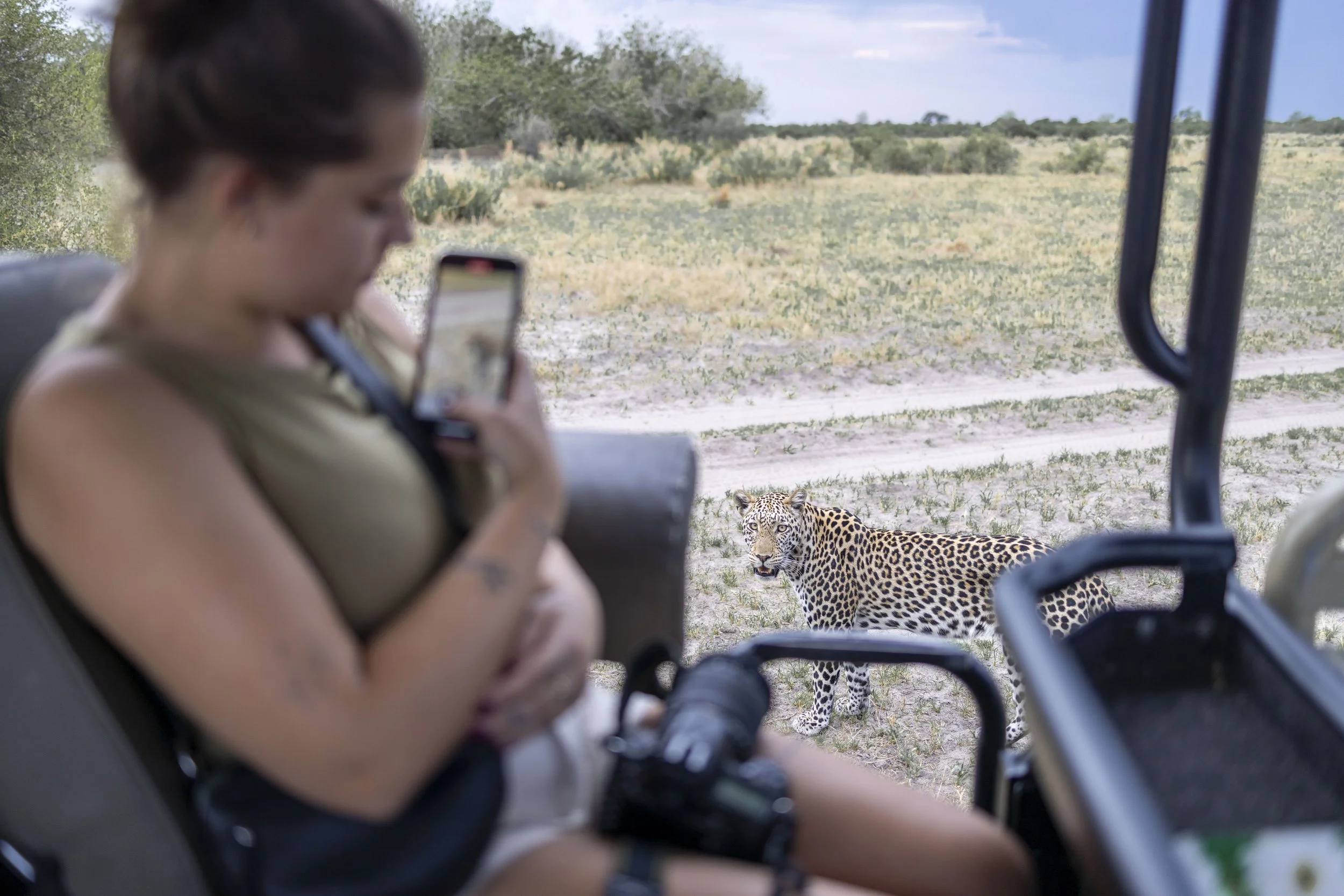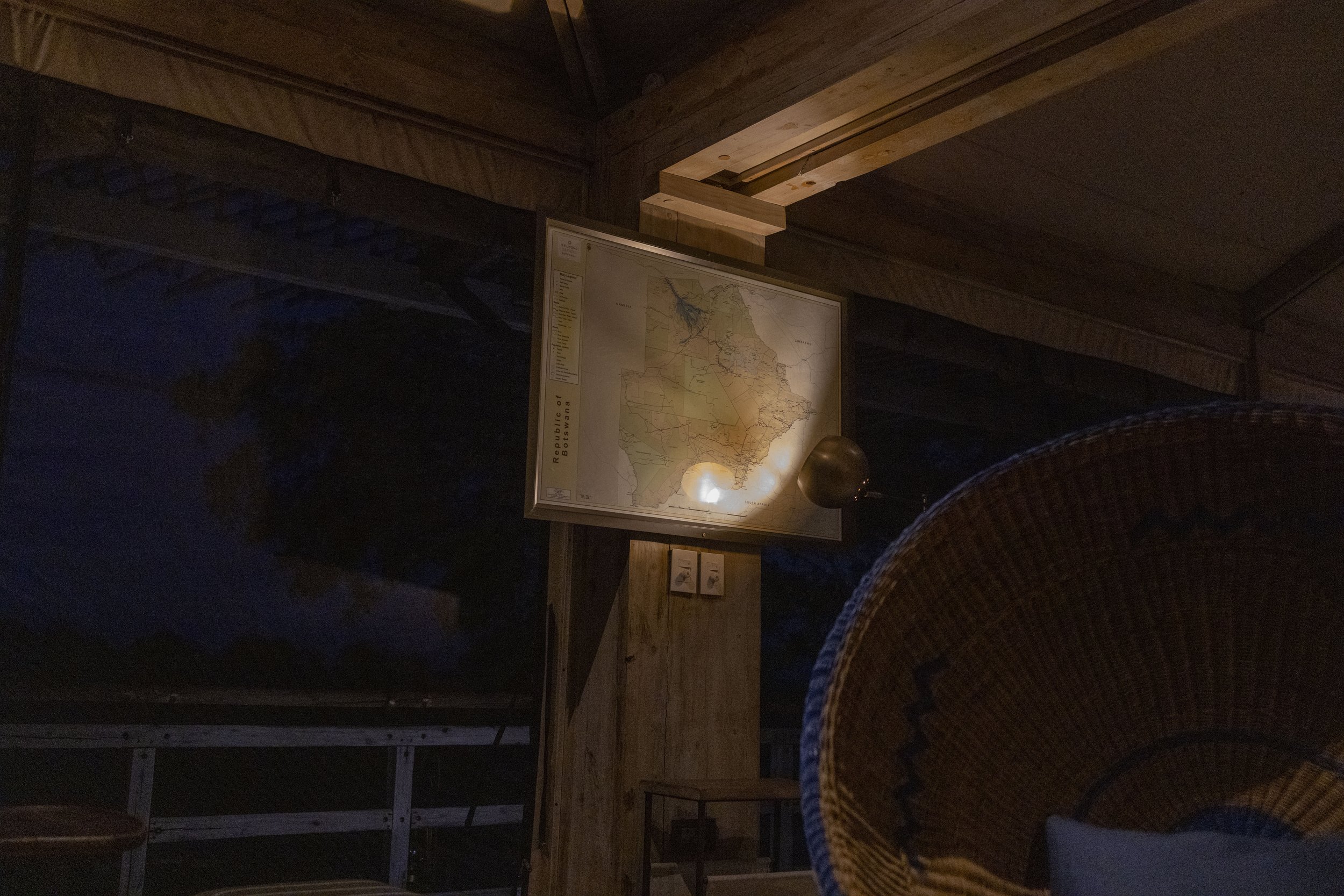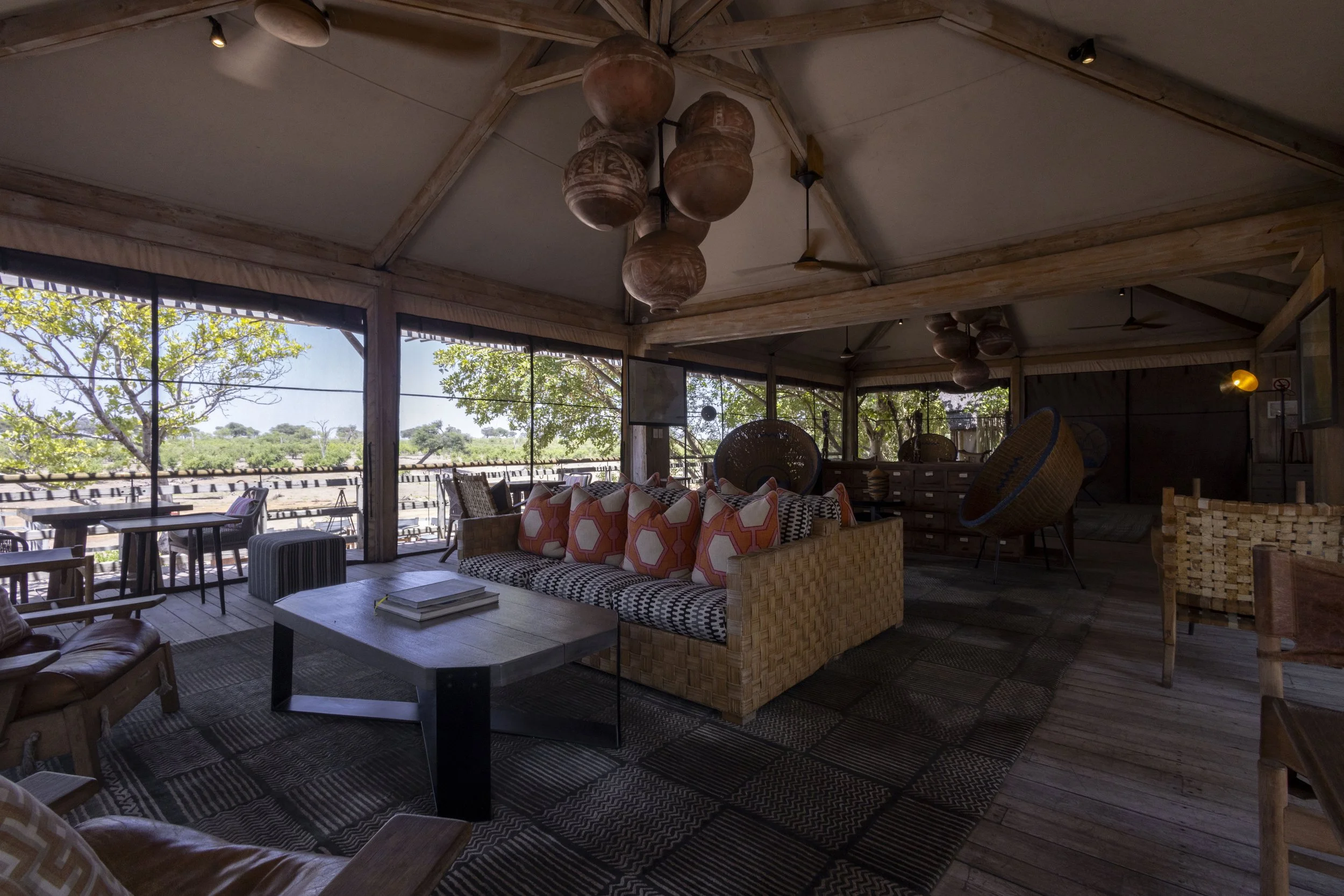Savute: Rain, Tracks, and Timeless Stories
Arrival Over the Okavango
Flying over the Okavango Delta is anything but ordinary. The rain had just passed, and the landscape below looked like it had been polished clean. Small green-yellow islands poked out of the shallow water which glistened on floodplains, reflecting the sky like shards of glass. From above, you could see the winding channels of the delta stretching out like veins, each one telling its own quiet story. Elephants crushing through the waist deep waters, crocodiles quickly disappearing, a glint of a hippo. Even from an aerial view, the Delta was very much alive.
When we landed, the smell of rain still hung in the air. The kind that sinks into the ground and lingers for hours. It felt like we’d arrived at exactly the right time — like the bush had been reset just before we stepped in.
A Welcome With Meaning
On the drive to Belmond's Savute Elephant Lodge, the bush didn’t take long to introduce itself. First, a red-crested korhaan strutted out in the open. For anyone unfamiliar with the korhaan, it’s a bird known for its confidence — and its unmistakable, staccato call. a banded mongoose darted across the road, its quick movements a flash of fur against the still-damp sand. Not far from there, John our guide smiled and called us "bringers of the rain," a small nod to local belief that good people bring good fortune. Given the timing of our arrival right only moments after the rain, it didn’t seem like a stretch. It’s one of those instances you nod at, half-smiling, wondering how often it turns out to be true.
We were met immediate at the entrance with an eager choir, “Dumela, welcome to Savute!” they resounded. As much as I wanted to capture that moment, more than anything I wanted to experience. Smiling, I soaked it in. Somehow, by evolving my dream, having the courage to sell myself, and a little luck, I was here. This moment was the physical manifestation that I could actually create a lifestyle surrounding what I love.
An Evening Gamble
After only a short respite we set out on an evening game drive. Normally, there’s a certain flow to tracking, scanning, and waiting. But this time, it was immediate. John received a radio call in isiXhosa and while I couldn’t discern it, I did pick up ‘ingwe’. There was a leopard out there. He informed us it was mobile and 8km out. It would be a rush and no guarantee of a sighting. Our original plan was to go look at bush paintings on a rocky outcrop and watch sunset from there. I deferred the decision to the other guest as I’d seen a leopard the day before at Kwapa and she was only there for a few days. More indecision led to me finally just saying, “Let’s gamble.”.
After what felt like only a few minutes drive, we noticed an over-landing vehicle parked at an angle with the driver pointing her telephoto lens into the bush. Sitting attentively, a lone leopard stared across an open floodplain at a herd of wildebeest with some young. You could could see the hunger, he was thin. Moments like that make you pause. You forget about the camera. You forget to speak. It’s just you, the leopard, and a shared space in a vast, wild world. The over-lander readjusts and he stands up, looks at our game viewer, and slowly walks beside us before deciding to sit down right in front of our car. RIGHT in front of our car. There is always a playful sense in sightings like these, a giddy anticipate to a moment that just keeps getting better and better.
Eventually, it moved on, but that moment stayed. I’ve seen leopards before, but it’s rare to see one in the open like that, unbothered and still.
Elephants and Thunder
Back at the lodge that night, thunder echoed in the distance, low and steady, like the bush breathing in and out. Lightning spread across the sky occasionally lighting up the bush below. Just beyond the lodge, three giant male elephants gathered at the waterhole. They moved with that same quiet patience elephants always seem to have, deliberate in every step.
Thunder, rain, elephants — it’s hard not to see the connection. It’s the rhythm of life here. No screens, no noise from outside life. Just this.
Tracks in the Sand
Tracking isn’t glamorous. It’s slow work, eyes on the ground, reading the sand like a story. That morning, we spent hours following leopard and lion tracks — paw prints left behind in the soft, wet earth. Every turn led to another track, and then another. But cats don’t move in straight lines. They weave. They backtrack. They disappear.
Eventually, we stopped for breakfast. Sometimes, you have to know when to let it go. As we unpacked the food and poured coffee, and soaked in the morning warmth.
The spot we stopped at felt older than time itself — a rock face bearing ancient paintings of wildlife. Giraffes, elephants, and other animals were etched into the stone, left there by the hands of people who lived off this land long before modern lodges and safari trucks existed.
Standing in front of those paintings, you feel something shift. You think about all the people who came here before you. Their days were spent walking these floodplains, not as visitors, but as part of the ecosystem. The animals they drew on the stone were not trophies or sightings for social media — they were stories, symbols of survival, and maybe even signs of gratitude.
The rock face wasn’t large, and there weren’t thousands of paintings, but it didn’t need to be. The stories etched into it said enough.
The lions we’d been tracking for hours were laying right there. Right there. No movement, no sign of struggle — just calm, resting lions not far from where we’d decided to stop.
If there’s a lesson in that moment, it’s this: You don’t always have to chase what you’re looking for. Sometimes, it’s closer than you think.
A Brunch With No Walls
We wrapped up our lion sighting with a brunch overlooking a dry floodplain. A lone male giraffe lazily brunched himself under an apple leaf tree. Bush brunches hit differently. No walls, no dining room, no ceiling — just open space and a table set on the floodplain. The food was as fresh as the air, and everything about it felt richer somehow. Maybe it’s the way the sunlight touches everything after the rain, or maybe it’s knowing that every sound around you could be something wild approaching.
These meals aren’t just about food. They’re about pause. It’s one of those rare moments in life where you slow down, not because you have to, but because it feels right. You’re sitting, eating, looking around, and suddenly you realize — you’re completely present.
The Flight Back to Maun
Flying out of Savute feels different than flying in. On the way in, you’re excited, looking for every animal below, scanning for wildlife. On the way out, it’s quieter. There’s reflection. There’s that pull you feel when you leave a place that still has more to teach you.
The water glistened below just as it had when we arrived, only this time, it felt like I understood it a little better. The floodplains, the tracks, the movement of the animals — it all made more sense now.
As the plane banked toward Maun, I watched the bush slowly fade into the horizon. You never really leave places like Savute. You carry them with you.
Closing Reflections
Savute isn’t just a destination on a map. It’s a place that stays with you long after you’ve gone. Every lion track, every leopard encounter, every drop of rain — it all sticks.
This wasn’t just another lodge experience. It was a reminder that no matter how many times you come to the bush, you’ll always leave with something new. The rain, the rocks, the roars — they’re all chapters in a story that’s been told for thousands of years.
If you'd like to follow along on the next chapter of this journey, stay tuned. There's always more to come.
I’m currently back home in Austin, Texas for the Christmas holidays. I’ll be in the states for some time and getting ready for the Dallas Safari Club convention in Atlanta, Georgia in early January.
Sign up below to be the first to know about what’s happening!









